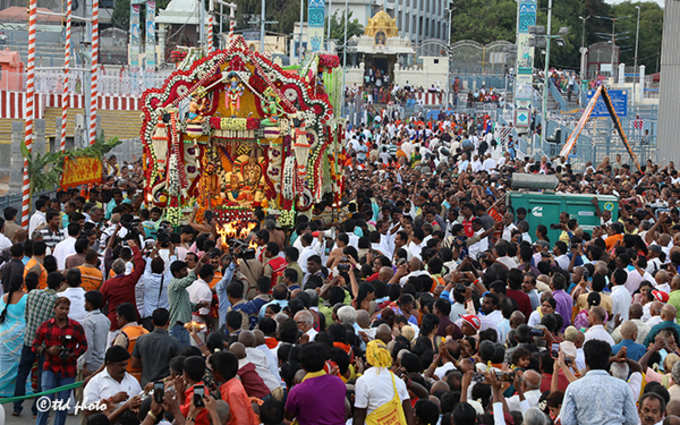

This is an ekanta seva, and pilgrims are not allowed to witness this ritual. It is followed by a second Archana when the Ashthottaranama (108 names of the Lord as given in the Varaha Purana) is read. The Second Bell or Aparanhapuja is the second Naivedyam for the Lord. The ringing of bells and Naivedyam are popularly known as the First Bell of the temple. Naivedyam is also offered to Vishwaksena, Garuda and the Nityasuries. At this point the doors of the Bangaru Vakili are closed. Naivedyam is announced by ringing the two bells, followed by Sattumura (recitation of a few psalms of the Divya Prabandhams by the Jiyangar or his assistant). THis seva take place for 45 minutes from 7.15 a.m- 8.00 a.m.įirst Bell – This is rung when the first Naivedyam is offered to the Lord, after it is presented to Varaha Swami. Hence everyday after the accounts are read out at Tirumala, the same are read out in front of Govindaraja Swami in Tirupati.Īfter the Koluvu is the First Archana which is also called the Sahasranama Archana wherein, the Lord is worshipped while reciting His 1008 names. So it is believed that till the end of Kali Yuga, Lord Vishnu promised to repay all that money to Govindaraja Swami. Govindaraja Swami ( Lord Vishnu's brother ) took on the task of procuring th e money from Kubera. The legend goes that Lord Vishnu borrowed a large sum of money from Kubera for his marriage to Goddess Padmavati. The income of the previous day is read out to the Lord, followed by the reading of astronomical details from the panchangam for the previous, current and the following days, Koluvu is always an Ekanta Seva. The idol is offered a mixture of fried and crushed gingelly seeds and jaggery. And during this seva, the idol of Koluvu Srinivasa, is seated in a gilt chair under the canopy of a gilt umbrella (presented to the temple by the Maharaja of Mysore), and holds a koluvu or darbar. This seva lasts 15 minutes from 7.00 a.m – 7. This seva lasts for 45 minutes.Īfter the Thomala Seva is the Koluva on all days except Fridays. During the service, the priest is assisted by an ckangi. The service comes to a close with the waving of the flame known as nakshatra-harati, the sprinkling of theertam, waving of vinjamara, and the priest decicating the service to the lotus feet of the Lord. The deity is then adorned with the flowers, while the Mantras are recited in the Sayana Mandapam. The water for the puja is brought from the Akasa Ganga waterfalls by a member of the Tirumala Nambi (the first citizen of Tirumala) familyl. Thomala Seva involves the decoration of the Lord with flower garlands along with a lit torch in a procession, to the accompaniment of the beat of the jeghanta. Thomala is derived from the Tamil word “Toditta Malai” (adorning the deity with garlands of flowers). This seva is performed on all days after Suddhi, except on Fridays when it is held after Abhishekam. Suddhi is when all the flower offering of the previous day and removed.Īfter the Suddi is the Thomala seva. On completion of Sarvadarsanam, a screen is placed at the Bangaru Vakili and Suddhi is conducted in the sanctum sanctorum. The Sataari is also placed on every devotee's head during Sarvadarsanam. Harati is performed and all devotees are given the teertham which is believed to have been worshipped by Lord Brahma and the Devas overnight. The pilgrims who undertake the Angapradakshinam have to bathe in the Swami pushkarini, and reach the Main Temple before the Saprabhatam starts.Īfter the Suprabhatam, Bhoga Srinivas Murti is awakened, after which Sarvadarsanam takes place. It is performed in the Vimana Pradakshinam. A pinch of this mixture is given to devotees during Sarvadarsanam.Īs the suprabhatam is being chanted you can see the devotees perform Angapradakshinam, chanting the Lord's name. At the time, sandalwood mixed with saffron and shaped as oranges is placed in a silver cup, and kept at the Lord's feet till the following morning. During Ekanta Seva, a direct descendant of Annamacharya sings the Lord to sleep.

Bhoga Srinivasa murti, the small silver image of the Lord is placed on a cot hung from the roof by four silver chains in the Ardha Mandapam (ante-chamber where devotees await the darshan of the Lord). A night time ritual to prepare the Lord for His night's rest is performed wherein milk and cashewnuts are offered to the Lord.


 0 kommentar(er)
0 kommentar(er)
